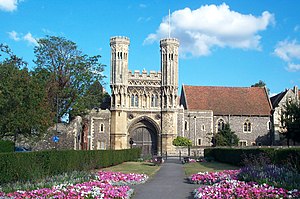Monastery of St. Augustine

Abbot Fyndon's Great Gate, with Lady Wootton's Green in the foreground, is a private entrance into the King’s School. The public entrance to the abbey ruins is on Longport.
|
|
| UNESCO World Heritage Site | |
|---|---|
| Location | United Kingdom |
| Coordinates | 51°16′41″N 1°5′18″E / 51.27806°N 1.08833°ECoordinates: 51°16′41″N 1°5′18″E / 51.27806°N 1.08833°E |
| Criteria | i, ii, vi |
| Reference | 496 |
| Inscription | 1988 (12th Session) |
| Website | www |
|
[]
|
|
St Augustine's Abbey was a Benedictine monastery in Canterbury, Kent, England. The abbey was founded in 598 and functioned as a monastery until its dissolution in 1538 during the English Reformation. After the abbey's dissolution, it underwent dismantlement until 1848. Since 1848, part of the site has been used for educational purposes and the abbey ruins have been preserved for their historical value.
In 597, Augustine arrived in Anglo-Saxon England, having been sent by the missionary-minded Pope Gregory I to convert the Anglo-Saxons. The King of Kent at this time was Æthelberht or Ethelbert. Although he worshipped in a pagan temple just outside the walls of Canterbury to the east of the city, Ethelbert was married to a Christian, Bertha. According to tradition, the king not only gave his temple and its precincts to St Augustine for a church and monastery, he also ordered that the church to be erected be of "becoming splendour, dedicated to the blessed apostles Peter and Paul, and endowed it with a variety of gifts." One purpose of the foundation was to provide a residence for Augustine and his brother monks. As another, both King Ethelbert and Augustine foresaw the abbey as a burial place for abbots, archbishops, and kings of Kent.
William Thorne, the 14th century chronicler of the abbey, records 598 as the year of the foundation. The monastic buildings were most likely wooden in the manner of Saxon construction, so they could be quickly built. However, building a church of solid masonry, like the churches Augustine had known in Rome, took longer. The church was completed and consecrated in 613. Ca. 624 a short distance to the east, Eadbald, son and successor of Ethelbert, founded a second church, dedicated to Saint Mary which also buried Kentish royalty. The abbey became known as St Augustine's after the founder's death.
For two centuries after its founding, St Augustine's was the only important religious house in the kingdom of Kent. The historian G. F. Maclear characterized St Augustine's as being a "missionary school" where "classical knowledge and English learning flourished." Over time, St Augustine's Abbey acquired an extensive library that included both religious and secular holdings. In addition, it had a scriptorium for producing manuscripts.
...
Wikipedia

